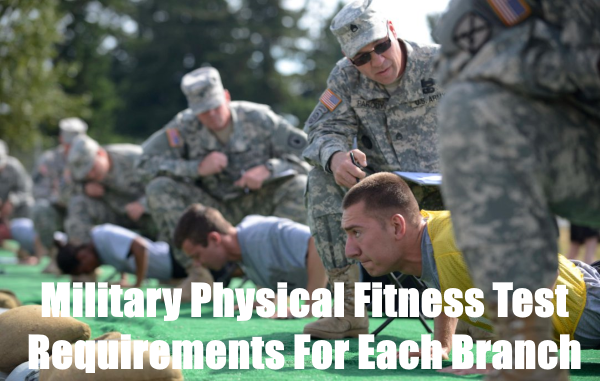Each branch of the U.S. Military requires physical fitness tests of its members.
This is an integral part of members’ health and wellness, as well as overall military training and job specialization.
In addition, each branch designates passing standards for their personnel when performing these tests to remain in good standing.
If you are considering joining one of the military branches, this article offers a comprehensive summary of each fitness test and its requirements.
Table of Contents
Army Physical Test Requirements
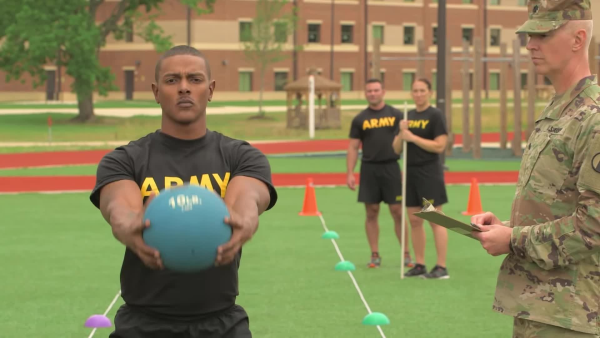
Recently, the Army has implemented the ACFT (Army Combat Fitness Test).
This test is designed to assess a broader scope of physical fitness among soldiers.
In addition, it offers practical applications for combat readiness.
The former version of the Army fitness test primarily measured muscle and aerobic endurance.
Currently, the ACFT measures ten areas of fitness:
- Muscle strength
- Muscle endurance
- Muscular power
- Speed
- Agility
- Aerobic endurance
- Balance
- Flexibility
- Coordination
- Reaction time
The ACFT is made up of six field events that soldiers must perform in a specific order.
The whole test takes just under an hour to complete.
Active-duty soldiers take the ACFT twice per year.
Each soldier is required to pass the same six individual events that make up the ACFT.
If a soldier does not achieve a passing standard for one or more of the events, then they will not pass the ACFT as a whole.
However, a soldier must complete the entire fitness test regardless of any individual failing score.
The maximum score for each event is 100 and the typical minimum passing score is 60 per event.
Therefore, the max ACFT score possible is 600 and the minimum standard for passing is 360.
However, depending on a soldier’s job or MOS, the passing standards may be higher.
Originally, ACFT scoring was gender-neutral.
However, recently, in March 2023, the scoring was adjusted to account for the age and gender of the participating soldier.
The performance of the events does not otherwise differentiate between male and female soldiers.
ACFT Events
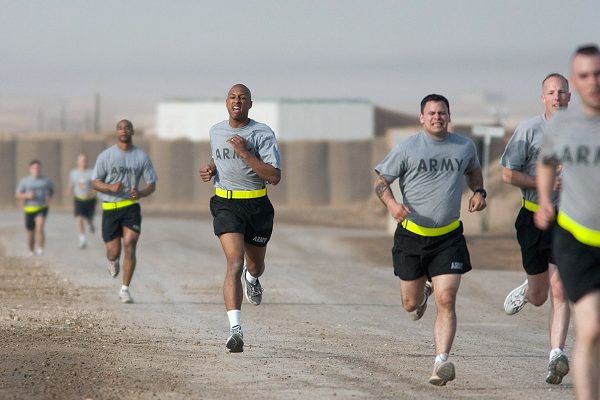
- Maximum deadlift: proper deadlift of weight ranging from 140 to 340 pounds for three repetitions
- Standing power throw: proper throw of a 10-pound medicine ball overhead and backward for the greatest distance
- Hand-release push-ups: proper push-up form and execution for as many as possible in two minutes
- Sprint-drag-carry: proper completion of five 25-meter dash shuttles in order, including sprint, 90-pound sled-drag, carry of 40-pound kettlebells, laterals, and final sprint
- Plank: a test of core strength by holding a plank position for as long as possible.
- Two-mile timed run: two-mile run on inside or outside track with a maximum time of 22 to 25 minutes. depending on age
Navy Physical Test Requirements
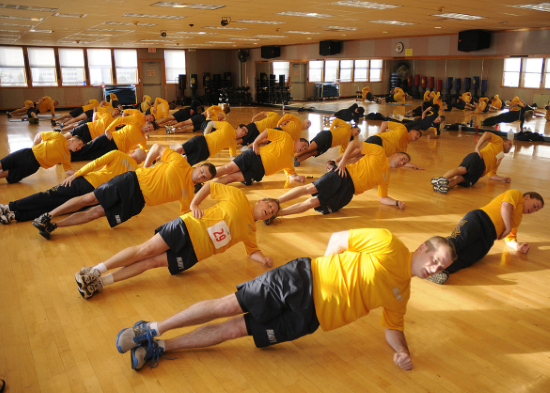
The Navy utilizes the Physical Readiness Test (PRT) to determine the physical fitness and readiness of its sailors.
This indicates the ability to meet the various physical demands of military service.
Like the Army, the Navy has made recent changes to the PRT.
This includes altering components of the test to improve a sailor’s physical performance.
This also reduces the risk of injury.
The Navy PRT is designed to measure the following physical attributes of sailors:
- Muscle endurance
- Aerobic capacity
- Body composition assessment (measuring height, weight, abdominal circumference, and body fat)
Recruits at the Navy’s boot camp are tested with the PRT.
In addition, all active duty and reserve sailors must take the PRT twice per year.
Traditionally, the PRT was made up of three events in the following order:
- curl-ups (as many as possible in 2 minutes)
- push-ups (as many as possible in 2 minutes)
- timed outdoor run of 1.5 miles
Related Article – Navy PRT Standards
New Changes to Physical Testing
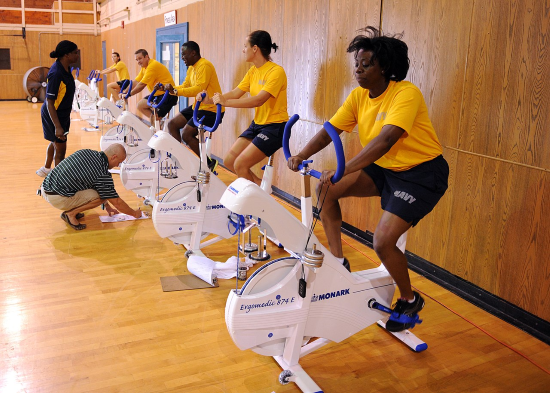
There are alternate cardio options to the 1.5-mile run, as per the discretion of the commanding officer.
These options include:
- Timed 500-yard swim
- 12 minutes on stationary cycle
- 5-mile run/walk on a treadmill
- 2-kilometer indoor row on rowing machine
As of 2020, the PRT curl-ups are replaced with a forearm plank exercise.
This exercise is similar to a push-up.
A sailor lifts their torso off the ground, supporting their weight on their toes, forearms, and elbows while keeping their body rigid.
This strengthens core muscles and poses less risk for lower back injuries than curl-ups.
Scoring for the PRT consists of performance categories: outstanding, excellent, good, satisfactory/probationary, and failure.
Within these five performance categories, a sailor can be rated at a high, medium, or low level.
In order to pass the PRT overall, a sailor must typically score in the satisfactory category at a medium level in all three events.
There are different scoring standards for men and women taking the PRT, in addition to different standards based on age groups.
Sailors should be aware of the minimum standard scores for each event as they are expected depending on gender and age.
Sailors in need of medical attention during the PRT may be authorized a makeup test at a later date.
In addition, sailors who pass the body composition assessment and score at an overall excellent/low-level on the PRT may have a future opportunity of foregoing their next PRT if certain standards are maintained.
Air Force Physical Test Requirements
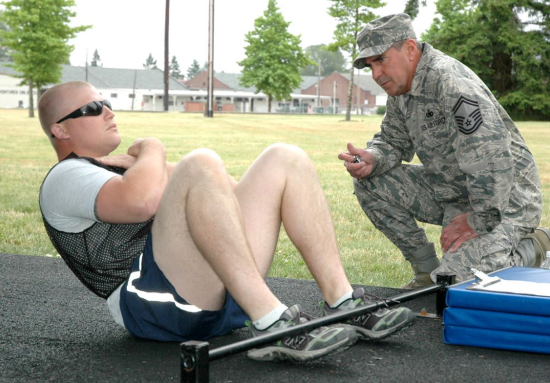
Like the Army and Navy, the Air Force also requires members to meet and maintain standards of physical fitness.
In early 2022, the Air Force implemented options for its physical fitness test so members can select the exercises they prefer.
The three categories of fitness testing are:
- Aerobic exercise
- Core strength
- Upper body strength.
Previously, the physical test for this branch featured a maximum of 60 points for performance on a 1.5-mile run.
Twenty points was the maximum awarded for body composition.
Ten points was the maximum score for muscular fitness, consisting of one-minute tests each for push-ups and sit-ups.
New Approach to Physical Testing

The new personalized approach to physical fitness testing allows members to determine how best to demonstrate their strengths.
Rather than all individuals performing the same physical exercises for assessment, the Air Force has developed equivalent fitness measures.
The cardio portion counts for 60% (60 points maximum) of the total physical training score.
Push-ups and sit-ups are now worth up to 20 points each.
This puts the new top score for the Air Force physical test components at 100 points total.
For aerobic exercise and to measure cardiovascular health, airmen can choose among the following:
- 1.5-mile run
- 20-meter high aerobic multi-shuttle run (sprint)
For upper body strength, there is a choice between traditional or hand-release push-ups.
For core strength, the choices are:
- traditional sit-ups
- cross-legged reverse crunches
- planks
Waist measurement is no longer a component of physical fitness test scoring.
This change took place as a result of concerns over accuracy and negative long-term effects such as eating disorders.
However, airmen are required to maintain weight standards and meet body composition metrics.
Airmen can schedule their physical test through the “myFitness” system.
In addition, there is an option to take a diagnostic version of the test.
This means that airmen can retake the test without any penalty if they fail but keep their score if they pass.
Finalized scoring charts for fitness assessment reflecting the new alternative components are yet to be provided.
These assessment standards will be differentiated by age brackets, grouped in five-year increments from 25-59.
There will also be differentiated standards for airmen under the age of 25 and over 60.
Scoring charts may reflect gender differentiation as well, though the Air Force is working towards gender neutrality in scoring for physical testing.
Marine Corps Physical Test Requirements
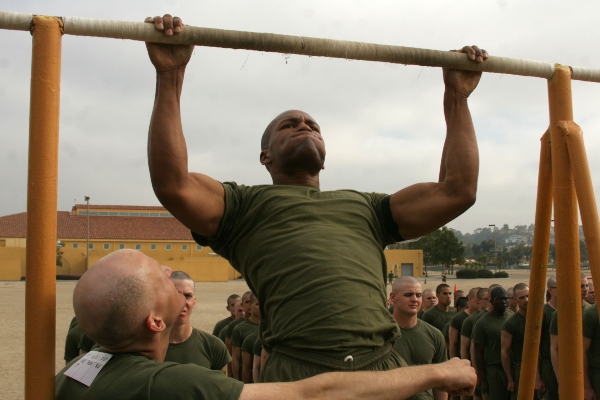
The Marine Corps Physical Fitness Test (PFT) is designed to evaluate stamina and physical conditioning.
The test is made up of three parts:
- pull-ups or push-ups
- timed plank
- timed three-mile run
Marines must take the PFT once a year to ensure they meet the standards and assess their battle readiness.
In the second half of the year, they take the Combat Fitness Test.
The PFT consists of pull-ups and push-ups to indicate upper body strength.
Planks are critical to demonstrate strong core muscles.
The three-mile run measures physical fitness and endurance.
The sequence of PFT events is determined by the commanding officer.
However, all events are conducted in a single session within a two-hour limit.
For events in which there is a choice, Marines must indicate before testing which option they will perform during testing.
Related Article – USMC PFT/CFT Calculator
PFT Events
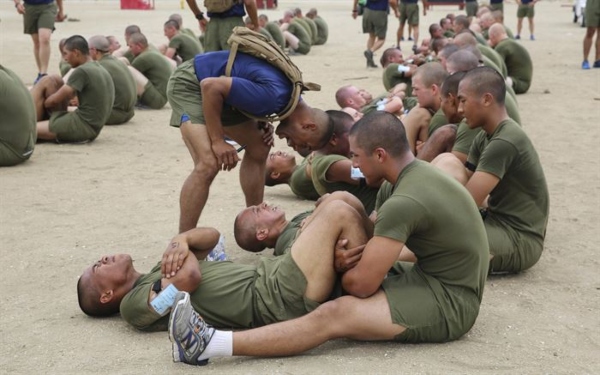
Here is a description of each PFT event:
- Hybrid pull-up / push-up test: Marines are given the choice between pull-ups or push-ups (not a combination). Pull-ups are encouraged, as maximum points on this test can be earned only by this choice. Push-ups are a timed event at 2 minutes, whereas pull-ups are not timed.
- Plank test: For the plank, Marines must maintain the proper position for as long as possible or until the maximum time is reached for 100 points.
- Three-mile run: This run is a timed event, conducted indoors or outdoors but not on a treadmill.
Marines must score at least minimum points on each event to meet standard levels and pass the PFT.
Failure to meet the minimum requirements in any singular event results in the failure of that event as well as the overall PFT.
Scoring tables are divided by gender for all age groups in all events.
For example, men aged 17 to 25 must complete the three-mile run in 27:40 minutes or less.
Women of the same age must complete the run in 30:50 minutes or less.
The minimum combined score to pass the overall PFT is 150.
However, earning the minimum performance score in each event will not reach 150.
In order to pass the PFT, Marines must earn additional points in at least one event.
PFT classification scores for all age groups are as follows:
- 235-300 points = 1st Class
- 200-234 points = 2nd Class
- 150-199 points = 3rd Class
All Marines are expected and encouraged to strive for optimal physical performance.
This includes reaching beyond minimum standards.
Coast Guard Physical Test Requirements
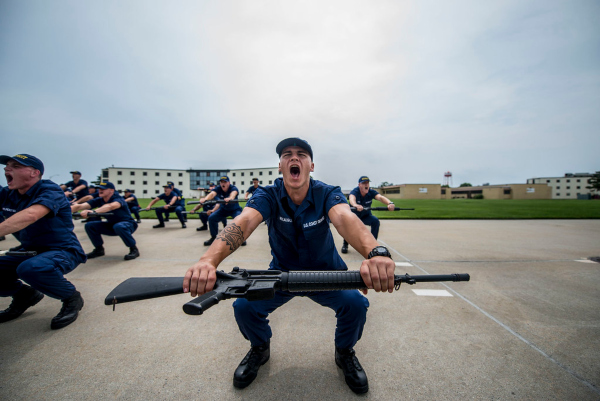
Members of the Coast Guard must take physical fitness assessments as part of their training and job requirements.
The key factors determining physical fitness in Coast Guardsmen are:
- Aerobic capacity
- Muscular strength
- Muscular endurance
Aerobic capacity is an indicator of cardiovascular fitness.
This component is considered most related to health as well as the ability to perform vigorous and/or sustained physical activity.
The Coast Guard’s Physical Fitness Assessment (PFA) consists of the following tests:
- Push-ups: This is a one-minute test in which members must do as many push-ups with proper technique as possible. The minimum standard for men under the age of 30 is 29 and for women of the same age is 15.
- Sit-ups: This is a one-minute test in which members must do as many sit-ups with proper technique as possible. The minimum requirement for men under 30 is 38 and for women under 30 is 32.
- 1.5-mile run: This is a timed run with a distance of 1.5 miles on level ground. Men under the age of 30 must complete the run no slower than 12:51 minutes and for women under 30 no slower than 15:26 minutes.
- Swim circuit: In this test, participants must jump from a 1.5-meter platform into the water and swim 100 meters without assistance.
Scoring for the Coast Guard Physical Fitness Assessment is differentiated by gender and age in 10-year increments.
All Coast Guard members are screened twice per year for height and weight standards in addition to taking the PFA.
These screenings and assessments are designed to ensure the health and fitness of Coast Guardsmen.
Conclusion
Each branch of the U.S. military has always emphasized physical fitness as part of their members’ overall training.
Recently, there have been both dramatic and subtle shifts in the military’s approach to assessing and incorporating physical fitness.
These goals are to benefit individual service members within their programs.
Though the Space Force is a branch of the military, it is not represented in this article.
Currently, this branch does not require its own physical fitness test.
In general, Space Force members follow Air Force fitness standards.
Physical fitness is an important element for health and well-being.
Whether you are a soldier, sailor, or otherwise, your physical health and fitness are essential for your job readiness.
In addition, physical fitness is vital to the security of your fellow military members in training.
Therefore, it’s advisable to understand and prepare for the standards and requirements for physical tests in each branch.
References
Army Combat Fitness Test (ACFT)
Guide 5-Physical Readiness Test PDF
Air Force releases cardio and strength fitness assessment alternatives
Physical Requirements | Marines
Section D. Physical Fitness Standards
- Replacing Dog Tags: 6 Things You Need to Know - June 28, 2024
- Navy OAR Test Study Guide - June 24, 2024
- 10 Best Sniper Movies of all Time - June 20, 2024
Originally posted on January 30, 2022 @ 8:35 am
Affiliate Disclosure: This post may contain affiliate links. If you click and purchase, I may receive a small commission at no extra cost to you. I only recommend products I have personally vetted. Learn more.
